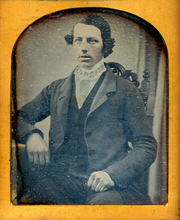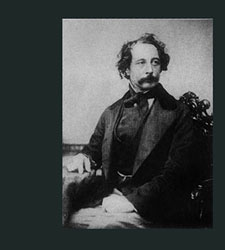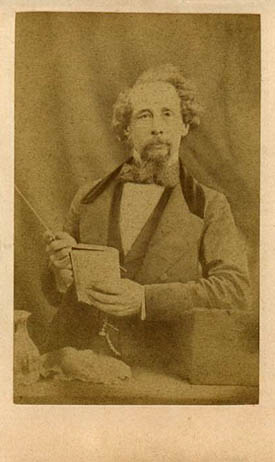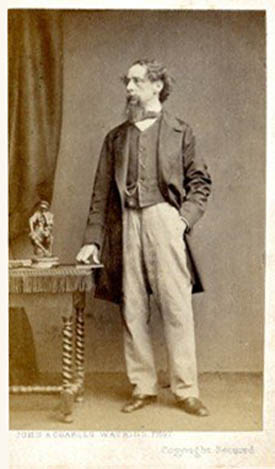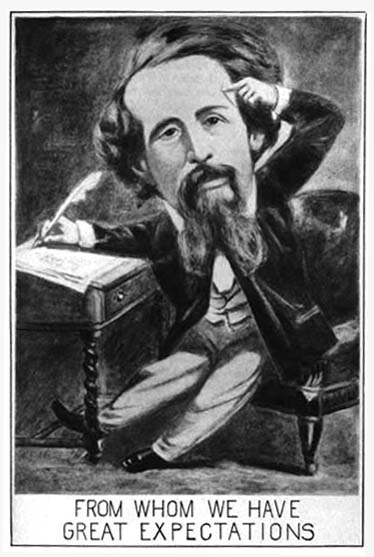| 1830 |

[ABOVE] Charles Dickens (aged 18). Miniature portrait by
Mrs Janet
Barrow (an aunt of Charles Dickens). This is the earliest authenticated
portrait of Charles Dickens as a young man and, given that it was created by
someone who knew him intimately and before he achieved fame as an author, is
probably the most honest representation of his features. |
| Charles Dickens was
probably the most famous writer and most popular novelist in Victorian
England. It is therefore not surprising that his face appeared in
hundreds of drawings, paintings, engravings and photographs between the
appearance of his first serialised novel in 1836 (The Pickwick Papers)
and his death in 1870, aged 58. The
most iconic and enduring picture of Charles Dickens is as a
sombre, balding man in late middle-age, sporting a grizzled, unkempt
beard, yet this image of the novelist was not established until the last
dozen years of his life. As a young man, Charles Dickens was
often described and presented as a smooth-faced, attractive, long-haired
individual with a liking for gaudy and fashionable clothes. As Lilia
Melani has written: "The young Dickens was very good-looking and
often described as pretty or delicate; he was something of a fop with
his flashy waistcoats, jewellery, and flowing long hair".
The most familiar image of Charles
Dickens as a serious- looking, bearded man in middle-age stems from
the photographic portraits which were sold as "celebrity
cartes-de-visite" during the 1860s, yet Dickens was first photographed
in 1841 at the dawn of photography, soon after Richard Beard had
opened England's first daguerreotype studio. This early daguerreotype of
Dickens, now sadly lost, would have shown a large-eyed, clean-shaven man
of twenty-nine, with long, flowing hair. There is evidence that
Charles Dickens had likenesses made at "daguerreotype portrait
galleries" in the late 1840s and early 1850s. When Charles Dickens posed
for a daguerreotype portrait in London around 1850, either at Antoine
Claudet's Adelaide Gallery or John Mayall's Daguerreotype
Portrait Gallery, he was in his late thirties and still
clean-shaven, but with thinning locks of hair. When he was aged around
42, Charles Dickens paid another visit to John Mayall's
Daguerreotype Portrait Gallery, but, by this time, Dickens had grown
a moustache. A tuft of hair beneath his lower lip and stubble on his
chin heralded the arrival of a beard which would, by 1857, have
developed into his trademark "door-knocker" beard.
The photographic portraits of Charles
Dickens, although not particularly revealing in terms of character,
reveal the actual physical appearance of the famous novelist and provide
a sharp contrast to the flattering portraits (such as those by Daniel
Maclise) which were either commissioned by his admirers or executed
by his close friends. |
|

|
| [ABOVE] Charles Dickens
in his late fifties, as depicted in a posthumous portrait by
Robert W. Buss (1804-1875). This watercolour painting entitled
"Dickens' Dream" shows Dickens contemplating the host of characters
he had created over a period of 40 years. Robert Buss's painting was
still unfinished when the artist died in 1875. |
|
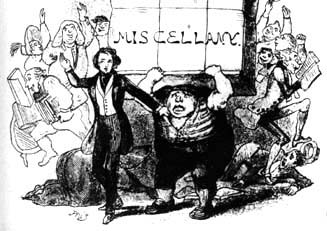
|
|
[ABOVE] Charles Dickens pictured leading a
burly porter carrying a huge consignment of Bentley's Miscellany,
a monthly magazine which Dickens edited between 1836 and 1839. This
woodcut engraving used to advertise Bentley's Miscellany
was originally drawn by Hablot Knight Browne ('Phiz')
in 1836 and featured in printed publicity for the magazine in March
1837. |
|
|
|
|
 |

|
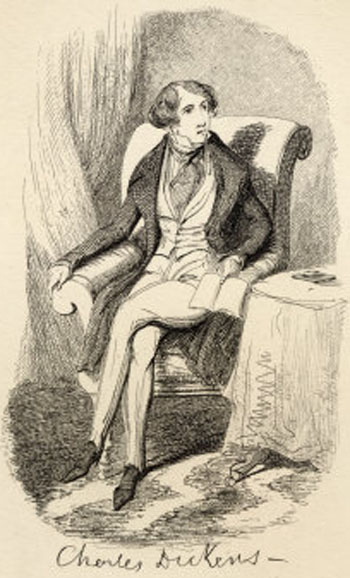 |
| |
[ABOVE] Charles Dickens (aged 23). Engraving after a
miniature portrait on ivory by Rosa Emma Drummond (born c1790), an
artist daughter of the painter Samuel Drummond (1766-1844). The original
portrait was painted to mark Charles Dickens' engagement in 1835. |
[ABOVE] A pencil sketch of Charles Dickens drawn by George Cruikshank
in 1836. |
George Cruikshank's pencil sketch was later worked up into
a finished drawing and then engraved for publication.
|
| 1837 |
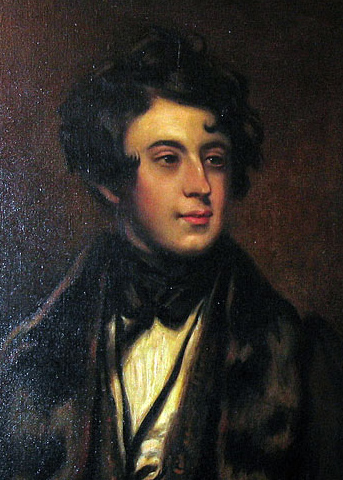
|

|
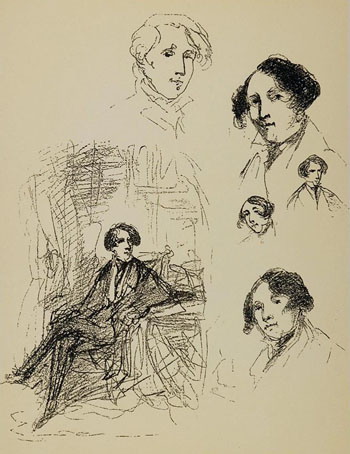
|
| |
[ABOVE] A supposed portrait of Charles Dickens (aged
about 25) painted by the artist Samuel Drummond (1766-1844).
Samuel Drummond had met Dickens when the author sat for a "wedding
engagement" portrait painted by Drummond's daughter Rosa Emma Drummond
(born c1790) at the Drummond family home. The painting was purchased by
Dickens' friend Angela Burdett-Coutts. Her secretary later wrote: "There can be no doubt whatever in my mind that the Baroness
Burdett-Coutts, who knew Dickens as a young man, considered it a genuine and
interesting portrait of the author". |
[ABOVE] Portrait sketch of Charles Dickens (aged 25),
drawn in April 1837 by George Cruikshank. One evening at a social
gathering, as Dickens sat in an armchair, conversing with his literary
friends, the artist and illustrator George Cruikshank exclaimed, "Sit
still, Charles, while I take your portrait!" At this stage Charles
Dickens was still clean shaven with "long brown hair falling in silky
masses over his temples." Before George Cruikshank made this
rough sketch he had met up regularly with Dickens because he had been
commissioned to illustrate "Sketches by Boz" (1836). |
[ABOVE] Sketches of Charles Dickens (aged 25), drawn
in April 1837 by George Cruikshank. The artist and illustrator
George Cruikshank (1792-1878) worked closely with Charles Dickens when
he provided illustrations for the young author's serialised novel "Oliver
Twist" (1837-1839). George Cruikshank's rough sketch of
twenty-five year old Charles Dickens sitting in an armchair was later worked up
into a finished drawing and then engraved for publication.
|
| 1837 |
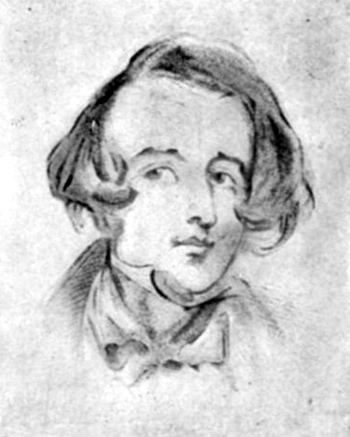
|

|

|
| |
[ABOVE] Charles Dickens (aged 25).
A print after a drawing by
Hablot Knight Browne
(1815-1882), a book illustrator who went
under the pen-name of 'Phiz'.
Between 1836 and 1859, Hablot Knight Browne
illustrated many works of Dickens, including
Pickwick and ten novels. |
[ABOVE] Charles Dickens in 1837, a lithographic print from an original
drawing by
Hablot Knight Browne ('Phiz').
This particular print is captioned CHARLES DICKENS (1837). From the
original drawing by 'Phiz'. The image has been reversed in the printing
process. |
[ABOVE] The print of Charles Dickens by "Phiz"
(Hablot Knight Browne)
reversed to show the original orientation of the artist's drawing of the
young author. Adopting the pseudonym of "Phiz", the artist Hablot Knight Browne went
on to illustrate Dickens' David Copperfield (1849-50). |
| 1838 |
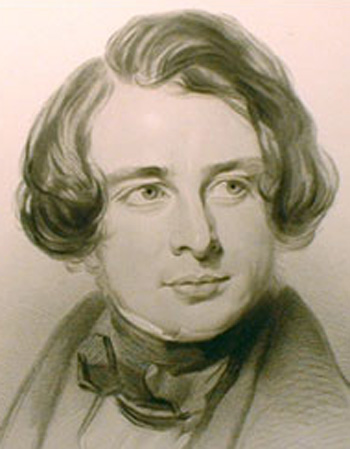 |
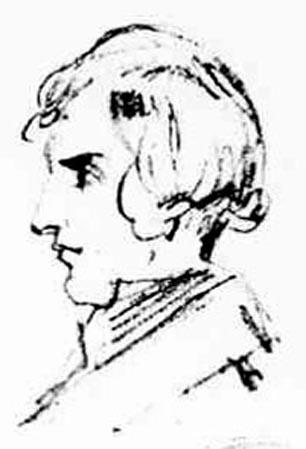 |
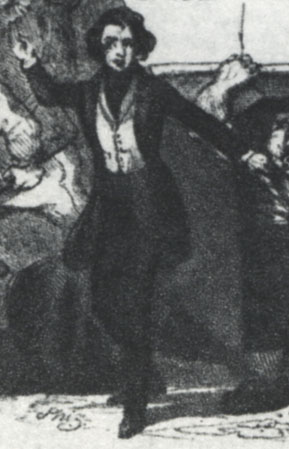
|
| |
[ABOVE] Charles Dickens (aged 26).
Engraved portrait after the 1838 drawing
in chalk by Samuel Laurence (1812-1884). An earlier portrait of
Dickens by Laurence is dated October 1837. |
[ABOVE] Charles Dickens as depicted in a sketch by
his then illustrator
Hablot Knight Browne
(1815-1882), who drew under the name of 'Phiz' |
[ABOVE] Charles Dickens pictured in an advertisement
for Bentley's Miscellany, a monthly magazine which Dickens
edited between 1836 and 1839. This woodcut engraving was based on an
original drawing done in 1836 by
Hablot Knight Browne ('Phiz'). |
| 1839 |

|

|

|
| |
[ABOVE] Charles Dickens (aged 27). A detail from the
oil painting "Portrait of Charles Dickens" by Daniel Maclise
(1806-1870). Daniel Maclise was
introduced to Charles Dickens by their mutual friend John Forster in
December 1836. Charles Dickens and Daniel Maclise
became close friends and Maclise appears to have hero-worship Dickens. (In
one drawing showing Charles Dickens reading to his friends in
December 1844, Daniel Maclise placed "a corona of inspired genius"
around the novelist's head). The famous female novelist George Eliot
(1819-1880) thought that this portrait of
Charles Dickens suffered "from odious beautification".
After receiving a copy of Mayall's daguerreotype
(c1849), the novelist George Eliot (Mary Ann Evans)
wrote in 1871: "We have just got a
photograph of Dickens, taken when he was writing, or had just written,
'David Copperfield' - a satisfactory refutation of that keepsakey,
impossible face which Maclise gave him, and which has been
engraved for the 'Life' (A biography of Charles Dickens by John
Forster).
It is clear that Daniel Maclise's portrait is an idealised version of
Dickens' features and probably reflects the high regard Maclise had for the
young novelist. |
[ABOVE] "Portrait of Charles Dickens",
an oil painting by Daniel Maclise (1806-1870). It appears that
Dickens was not very pleased with Maclise's early studies of his head and,
according to one source, "Dickens had Daniel Maclise throw out all his
early sketches and begin again from scratch". On 28th June 1839,
Charles Dickens remarked in a letter that "Maclise has made
another face of me, which all people say is astonishing." The author
William Makepeace Thackery (1811-1863), writing in 1840 under the
pseudonym of Michael Angelo Titmarsh made these comments about the
Maclise portrait of Dickens:
| "
Look, at the portrait of Mr. Dickens,
well arranged as a picture, good in colour, and light and
shadow, and as a likeness perfectly amazing ; a looking-glass could
not render a better facsimile. Here we have the real identical man
Dickens : the artist must have understood the inward Boz as well as
the outward before he made this admirable representation of him. What
cheerful intelligence there is about the man's eyes and large forehead
! The mouth is too large and full, too eager and active, perhaps; the
smile is very sweet and generous." |
|
[ABOVE] A coloured engraving of Charles Dickens that
appeared in the frontispiece of The Life and Adventures of Nicholas
Nickleby (1839). This engraving by William Finden (1787-1852) was
copied from
the famous oil painting "Portrait of Charles Dickens" by
Daniel Maclise. This engraving and other versions of the Maclise
portrait came to be known as the "Nickleby
Portrait". Daniel Maclise was unhappy with the woodcut versions
of his original artwork as this letter to John Forster demonstrates:
"I can never hope to get you to understand how I
am mortified and humiliated by the effect of these damnable cuts. It really
is too much to be called upon to submit to, to be shown up in these little
dirty scratches and to have one's name blazoned as if one was proud of them.
I wish to Heaven you would have my name cut out from the corners, that at
least I might have the benefit of the doubt as to which of the blots is mine
...My curses light upon the miserable dog that produced it - I don't mean
myself." |
| 1840 |
 |

|

|
| |
[ABOVE] Charles Dickens (aged 27). A print taken from
a profile portrait of Charles Dickens by Richard James Lane, ARA (1800-1872).
This view of the right-side of Dickens' head suggests the writer was already
balding in his late twenties. Was the original drawing by Lane a pencil
study to show the contours of Dickens' head? |
[ABOVE] An engraving after the portrait study of Charles Dickens
(circa 1840) by Richard James
Lane. This version has emphasised Dickens' balding pate. Portraits made
from life in 1842 show no evidence of this loss of hair, but Dickens might
have been using some kind of "comb over". |
[ABOVE] Charles Dickens depicted in an engraving based on
the original Maclise painting of Dickens, which came
to be known as the "Nickleby Portrait". Dickens parted his hair on
the right side of his head, with the long locks of his hair falling over his
left ear. From 1841, Dickens preferred to show his head from the left,
especially when in profile. (See below) |
| 1841 |
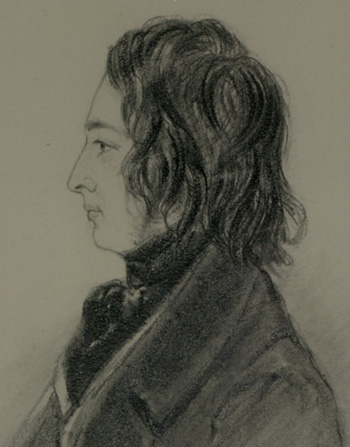
|
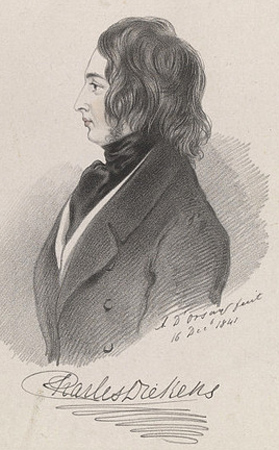
|
| "He is a fine little fellow,
Boz (Charles Dickens), as I think;
clear blue intelligent eyes, eyebrows that he arches amazingly, large
protrusive rather loose mouth, - a face of the most extreme
mobility, which he shuttles about, eyebrows, eyes, mouth and all,
in a very singular manner while speaking; surmount this with a loose
coil of common-coloured hair, and set it on a small compact figure,
very small, and dressed rather a la d'Orsay than well: this is
Pickwick (Charles Dickens); -for
the rest a quiet shrewd-looking little fellow, who seems to guess
pretty well what he is, and what others are". Thomas
Carlyle writing to his brother, John, on meeting Charles
Dickens at a dinner party. (17th March 1840) |
|
| |
[ABOVE] Charles Dickens (aged 29). A drawing by
Alfred Guillaume Gabriel, Count D'Orsay (1801-1852), a French amateur
artist, man of fashion and friend of Charles Dickens.
Some biographer
of Dickens claim that the dandified appearance affected by Dickens was
modelled after Count D'Orsay. The pencil drawing is signed "A. D'Orsay,
16th December 1841". |
ABOVE] An engraving after the profile portrait of Charles Dickens
by Alfred, Count D'Orsay, signed
"A. D'Orsay,
16th December 1841"and inscribed with Charles
Dickens' signature. There is a story that Dickens was not pleased with the
way that Count D'Orsay had rendered his chin in the original drawing and
asked his friend to modify it so it appeared less weak. |
|
| 1841 |
 |

|
|
| |
[ABOVE] Charles Dickens (aged 29).
A 19th century lithographic print from a
'lost portrait' of Charles Dickens. This portrait provides an approximate
depiction of how Charles Dickens might have looked around the time he sat
for his first daguerreotype portrait around May 1841. Richard Beard's
daguerreotype portrait studio at The Polytechnic Institution in London's
Regent Street had opened a few months earlier in March 1841. |
[ABOVE] An early daguerreotype
studio, as depicted in a woodcut by George Cruikshank in 1842. This
illustration shows the interior of Richard Beard's daguerreotype portrait
studio at the Royal Polytechnic Institution at 309 Regent Street, London,
the first commercial photographic portrait studio in England, which opened
on 23rd March 1841. Dickens sat for his portrait at Beard's studio at the
top of the Polytechnic building before the end of May 1841. |
[ABOVE] Daguerreotype portraits
of unknown young men photographed in the early 1840s and 1850s. In May 1841,
Charles Dickens studio wrote to a friend: "If anybody should
entreat you to go to the Polytechnic Institution and have a Photographic
Likeness done - don't be prevailed upon, on any terms. The Sun is a great
fellow in his way, but portrait painting is not in his line. I speak from
experience, having suffered dreadfully." |
| 1842 |

|

|

George Washington Putnam (1812-1896) who served as Charles Dickens'
secretary during his stay in America, provided an eye-witness account of
how the sculptor Henry Dexter modelled Dickens' head:
"While Mr. Dickens ate his breakfast, read his letters, and
dictated his answers, Dexter was watching with the utmost earnestness the
play of every feature, and comparing his model with the original. Often
during the meal he would come to Dickens with a solemn, business-like air,
stoop down and look at him sideways, pass round and
take a look at the other side of his face, and then go back to his model and
work away for a few minutes; then come again and take another look and go
back to his model; soon he would come again with his callipers and measure
Dickens's nose, and go and try it on the nose of the model; then come again
with the callipers and try the width of the temples, or the distance from
the nose to the chin, and back again to his work, eagerly shaping and
correcting his model. The whole soul of the artist was engaged in his task,
and the result was a splendid bust of the great author. Mr. Dickens was
highly pleased with it, and repeatedly alluded to it, during his stay, as a
very successful work of art". From "Four Months with
Charles Dickens" by George Washington Putnam (1870)
"His features, taken together, were well proportioned,
of a glowing and cordial aspect, with more
animation than grace, and more intelligence than
beauty". Editor of the Worcester Egis (February 1842)
|
|
| |
[ABOVE] Charles Dickens (aged 30).
This portrait of Charles Dickens was painted by the American artist
Francis Alexander (1800-1880) early in 1842, shortly after Dickens
arrived in Boston at the start of his first visit to North America. A young
American
George Washington Putnam (1812-1896), who was studying portrait painting
under Francis Alexander, observed the progress of the portrait in the
painter's studio in January 1842.
George Putnam later wrote:
"The engravings in his books which had then been issued
either in England or America were very little like him. Alexander
chose an attitude highly original, but very characteristic. Dickens is
represented at his table writing. His left hand rests upon the paper. The
pen in his right hand seems to have been stopped for a moment, while he
looks up at you as if you had just addressed him. His long brown hair,
slightly curling, sweeps his shoulder, the bright eyes glance, and that
inexpressible look of kindly mirth plays round his mouth and shows itself in
the arched brow. Alexander caught much of that singular lighting up of
the face which Dickens had, beyond any one I ever saw, and the picture
is very like the original, and will convey to those who wish to know how 'Boz'
(Dickens)
looked at thirty years of age, an excellent idea of the man." |
[ABOVE] Charles Dickens (aged 30). Sculptured bust by
the American sculptor Henry Dexter (1806-1876).
"Alexander's picture and Dexter's bust of Dickens should be exhibited at this
time, that those who never saw him in his young days may know exactly how
he looked. The bust by Dexter has the rare merit of action, and
in every respect faithfully represents the features, attitude, and look of
Charles Dickens." G. W. Putnam George
Washington Putnam (1812-1896)"He is a gay, free and
easy character;-a fine bright face; blue eyes, long dark hair, and withal a
slight dash of the Dick Swiveller in him." Henry Wadsorth
Longfellow on meeting Charles Dickens in Boston in 1842. Dick Swiveller
is an amiable character in Dickens' novel "The Old Curiosity Shop"
(1840-1841)
|
| 1843 |
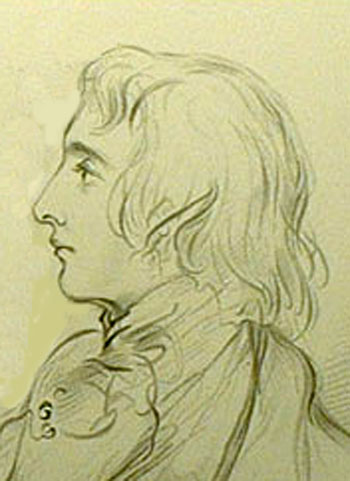
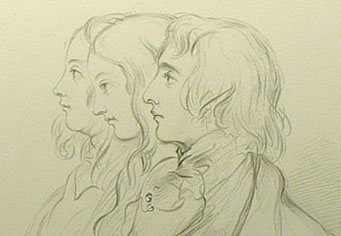
[ABOVE] Charles Dickens, his wife Catherine and his
sister-in-law Georgina Hogarth by Daniel Maclise (1843) |
"We found a middle-sized person in a brown frock
coat, a red figured vest, somewhat of the flash order,
and a fancy scarf cravat, that concealed the collar and
was fastened to the bosom in rather voluptuous folds
by a double pin and chain. His proportions were well-
sounded, and filled the dress suit he wore. His hair,
which was long and dark, grew low upon the brow, had
a wavy kink where it started from the head, and was
naturally, or artificially, corkscrew, as it fell on either
side of his face. His forehead retreated gradually from
the eyes, without any marked protuberance save at the
outer angle, the upper portion of which formed a prominent
ridge, a little within the assigned position of
the organ of ideality. The skin on that portion of the
brow which was not concealed by the hair instead of
being light and smooth, flushed as readily as any part
of the face, and partook of its general character and
flexibility. The whole region about the eyes was prominent
with a noticeable development of nerves and
vessels indicating, say the phrenologists, great vigour
in the intellectual organs with which they are connected.
The eyeballs completely filled their sockets. The aperture
of the lids was not large, nor the eye uncommonly
clear or bright, but quick, moist and expressive. The
nose was slightly aquiline, the mouth of moderate
dimensions, making no great display of the teeth, the
facial muscles occasionally drawing the upper lip most
strongly on the left side, as the mouth opened in speaking,
His features, taken together, were well proportioned,
of a glowing and cordial aspect, with more
animation than grace, and more intelligence than
Editor of the Worcester Egis (February 1842) |
|
|
"He is young and
handsome, has a mellow, beautiful eye, fine brow, and abundant hair.
His mouth is large, and his smile so bright it seemed to shed light
and happiness all about him. His manner is easy negligent but not
elegant. His dress was foppish; in fact, he was overdressed, yet his
garments were worn so easily they appeared to be a necessary part of
him. He had a dark coat, with lighter pantaloons; a black waistcoat,
embroidered with coloured flowers; and about his neck, covering his
white shirt-front, was a black neck-cloth, also embroidered in
colours, in which were placed two large diamond pins connected by a
chain ; a gold watch-chain, and a large red rose in his button-hole,
completed his toilet."
Eyewitness description of Charles Dickens as he
appeared at a party given by Judge Walker in Cincinnati, Ohio, in
April 1842. |
|
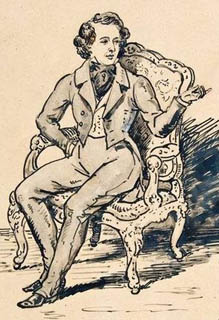
|
| Charles Dickens by Leonardo
Cattermole (c1844-95) |
|
| |
[ABOVE, TOP] Charles Dickens (aged 31). A detail from an engraving which
showed Charles Dickens, his wife Catherine Dickens and his sister-in-law
Georgina Hogarth, based on an 1843 pencil drawing by Dickens' friend Daniel
Maclise (1806-1870). Another close friend of Dickens, John Forster
wrote: "The likenesses of all are excellent; nothing ever done
of Dickens himself has conveyed more vividly his look and bearing at this
yet youthful time. He is in his most pleasing aspect; flattered, if you
will; but nothing that is known to me gives a general impression so
life-like and true of the then frank, eager, handsome face." |
|
Biography of Charles
Dickens |
|
|
|
[ABOVE] This drawing of Charles Dickens as he
appeared in the 1840s was executed many years after the event by
Leonardo F. G. Cattermole (c1844-1895), the son of the artist George
Cattermole. The drawing was apparently based on sketches and
reminiscences of the artist's father George Cattermole (1800-1868), a
friend of Dickens who contributed illustrations to Dickens' novels The
Old Curiosity Shop (1840-1841) and Barnaby Rudge (1841). Dickens
evidently visited the Cattermoles when Leonardo was a young boy. Leonardo
recalled Dickens' wonderful ability "to render himself interesting to,
and beloved by, children, who felt that he adapted himself without
'condescending' to them' |
|
|

|

|
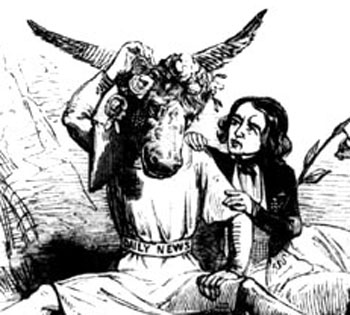
[ABOVE] Charles Dickens represented as 'Titania'
comforting 'Bottom' in a parody of a scene from Shakespeare's 'A
Midsummer Night's Dream'. The figure of 'Bottom' represents The
Daily News, a newspaper founded in 1846 by Dickens, who also served
as the paper's editor in the early months of 1846. This cartoon accompanied
a satirical verse published on 14th February 1846.
[BELOW] Charles Dickens reading to his
friends, as drawn by Daniel Maclise in December 1844. (The artist
Maclise is at bottom right). |
| |
[ABOVE] Charles Dickens (aged 32). An engraving based
on a miniature portrait by the artist Margaret Gillies
(1803-1887). This version of Margaret Gillies'
portrait, probably done in 1843, was engraved by James Charles Armytage
(1820-1897) for an 1844
publication "A New Spirit of the Age". Dickens wrote "Heaven knows, my portrait looks in my
eyes a little like the Iron Mask without the Man in it!" |
[ABOVE] Charles Dickens as depicted in a portrait by the
Newcastle artist Stephen Humble (1812-1858). Although clean shaven for most of the 1840s, Charles Dickens
did occasionally experiment with growing facial hair. In a letter from Italy
in 1844, Dickens He wrote to his friend Daniel Maclise: "The moustaches
are glorious, glorious. I have cut them shorter, and trimmed them a little
at the ends to improve their shape. They are charming, charming. Without
them, life would be a blank". |

|
|
|
 |
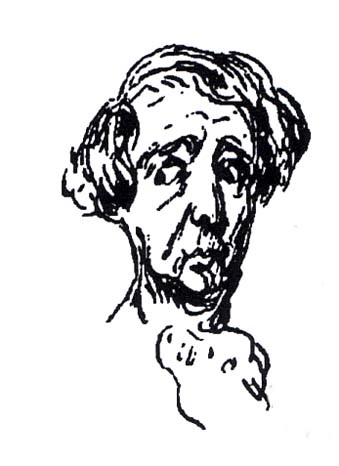
|
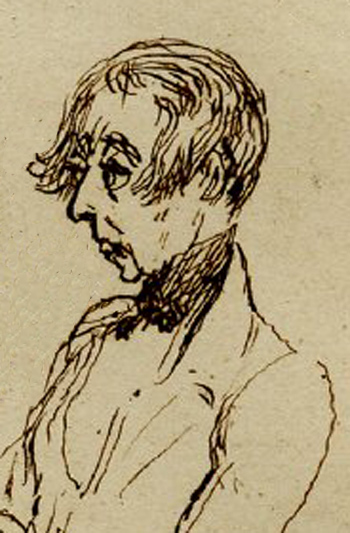 |
| |
[ABOVE] Charles Dickens (aged 35) acting in the role
of Sir Charles Coldstream in the play "Used Up", a two-act comedy
written by Charles Matthews and the Anglo-Irish dramatist Dion Boucicault in
1844. This is a detail from an 1847 painting by Augustus Egg
(1816-1863) entitled "Charles Dickens in the
character of Sir Charles Coldstream in Charles Matthews' 'Used Up'
". Both Charles Dickens and his artist friend Augustus Egg (in
the role of Mr Fennel the lawyer) appeared in public performances of the
play between 1848 and 1852. |
[ABOVE] A caricature of Charles Dickens
sketched in the mid or late 1840s by the humorous artist and cartoonist Richard Doyle
(1824-1883). Doyle began illustrating Charles Dickens' stories around
1843 and socialised with Dickens and the novelist's friends John Forster and
Douglas William Jerrold. Richard Doyle made portrait sketches of Dickens, Forster
and Jerrold in the mid 1840s. |
[ABOVE] Another caricature of Charles Dickens
sketched in the mid or late 1840s by the humorous artist Richard Doyle
(1824-1883). The novelist is still clean-shaven, but his receding hair has
been cut shorter so it no longer completely covers his ears. Doyle's
caricatures are an antidote to the flattering portraits produced by Dickens'
close friend Daniel Maclise. |
| 1849 |
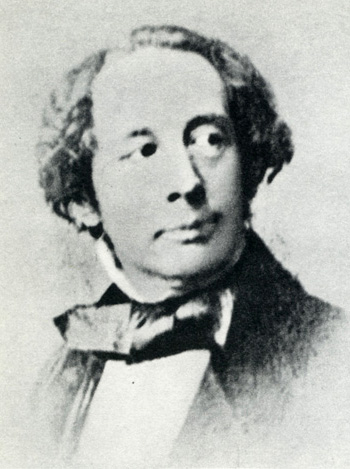
|

|
 |
| |
[ABOVE] Fig. 1. A photograph of Charles Dickens (aged
37) copied from a daguerreotype portrait taken around 1849. The original
daguerreotype has been attributed to John Jabez Edwin Mayall
(1813-1901), a British portrait photographer who is known to have taken
several pictures of Charles Dickens in the late 1840s and during the
1850s. John Jabez Edwin Mayall was
born near Oldham, Lancashire in 1813, but he gained his experience in
daguerreotype photography in Philadelphia between 1842 and 1846. Mayall
established a "daguerreotype institution" in the Strand, London, early in
1847. The image above has been reversed to show how the novelist appeared in
life, with his hair parted on his right. The original daguerreotype was
probably laterally reversed and the engravings based on the daguerreotype
provide a "mirror image", with the parting in Dickens's hair appearing on
the left-hand side of his head. A few daguerreotypists used cameras equipped
with a reversing prism or a mirror to create an un-reversed image. |
[ABOVE] Fig. 2. This photographic portrait shows Charles
Dickens in 1849 when he was working on his serialised novel "David
Copperfield" (published between May 1849 and November 1850). This is
one of the earliest surviving photographic portraits of Charles Dickens and
one of the few photographic portraits of the author which shows him
clean-shaven. The original daguerreotype is believed to have been taken
around 1849 by John Jabez Edwin Mayall (1813-1901).
The famous female novelist George Eliot (who had posed for Mayall in
1858) wrote in 1871: "We have just got a photograph of Dickens,
taken when he was writing, or had just written, 'David Copperfield' - a
satisfactory refutation of that keepsakey,
impossible face which Maclise gave him, and which has been engraved
for the 'Life' (biography). This photograph is the young Dickens
corresponding to the older Dickens to whom I knew - the same face, without
the unusually severe wear and tear of years which his latest looks
exhibited." |
[ABOVE] Fig. 3. Charles Dickens (circa 1849), a print
based on a daguerreotype of the novelist taken at John Mayall's portrait
studio at 433, West Strand, London around 1849.
This particular engraving is printed with the inscription "Portrait of
Dickens. From a Daguerreotype by J. Mayall, 1849. Taken while writing
Copperfield". A similar etching, clearly taken from the same Mayall
photograph carries the caption "Charles Dickens. From a Daguerreotype taken
while writing David Copperfield". The reference to Charles
Dickens' novel David Copperfield dates the original
daguerreotype to the period 1849-1850.
|
|
|
 |

|
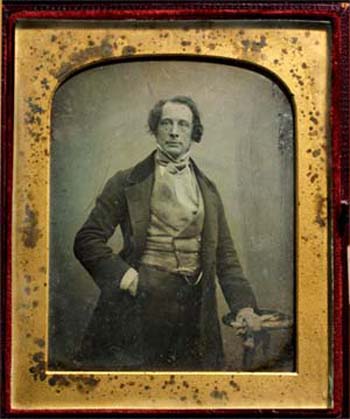
|
| |
[ABOVE] Fig.1. A photograph of Charles Dickens (aged
38), copied from a daguerreotype portrait taken around 1850. The original
daguerreotype has been attributed to both Antoine F. J. Claudet and
John J. E. Mayall, but most commentators now seem to agree that the portrait
was taken at Claudet's Adelaide Gallery, 18 King William Street, West
Strand, London, around 1850. Antoine Claudet (1797-1867)
established his daguerreotype portrait gallery in the Lowther Arcade,
Strand, Westminster in June 1841, just a few
months after Richard Beard had opened for business at The Royal
Polytechnic Institution, Regent Street, London, England's first ever
photographic portrait studio. Richard Beard, who believed he had
exclusive rights to the daguerreotype process in England, took legal action
against Claudet to prevent him taking daguerreotype portraits in England.
The court initially ruled in Beard's favour, but Claudet's appeal was
successful. Antoine Claudet (1797-1867) operated a daguerreotype
portrait gallery at 18 King William Street, London, until June 1851.
(For over 3 years Claudet also managed a daguerreotype portrait studio on
the First Floor of the Colosseum in Regent's Park, London). On
16th June 1851, Claudet opened a new set of Daguerreotype Portrait Rooms at
107 Regent Street, London. Claudet operated as a portrait
photographer at his Regent Street premises until his death in December 1867. |
[ABOVE] Fig.2. A photograph of Charles Dickens (aged
38), copied from a daguerreotype portrait taken around 1850. The
daguerreotype did not involve a negative, so to produce more copies, an
original had to be re-photographed. It is now generally accepted that
Charles Dickens had this likeness taken at The Royal Adelaide Gallery of
Practical Science, West Strand, London. The Adelaide Gallery had been
opened for the purpose of photographic portraiture in June 1841 by
Antoine Francois Jean Claudet (1797-1867), a French-born glass merchant.
Antoine Claudet had been born in Lyons, France, but in 1827 he
came to London to set up a glass manufacturing business. In 1839,
Claudet visited Louis J. M. Daguerre of Paris, the inventor of the
daguerreotype photographic process. Antoine Claudet purchased from Daguerre
the license to work his photographic process. Antoine Claudet is
mentioned by name in an article entitled 'Photography',
published in Charles Dickens' Household Words" in 1853.
| "It is to
M. Claudet that the public is indebted for the greater ease we now
enjoy in photographic sittings, and it is the same gentleman who informs
us that five minutes - not five-and-twenty- was the time required for
the formation of a good picture on the plates prepared in the old way."
From "Photography"
in Household Words (19th March 1853) |
Antoine Claudet was still making daguerreotype portraits at his
photographic studio at 107 Regent Street, London in 1858. |
[ABOVE] Fig.23. A full view of a cased daguerreotype
portrait of Charles Dickens which dates from around 1850. This
particular daguerreotype is usually attributed to Antoine Francois Jean
Claudet (1797-1867). There appears to be a slight difference in the pose
when compared to the photographic copy illustrated on the left (Fig. 2). In
the above image, the fingers of Dickens' left hand extend over the edge of
the small occasional table, in Fig. 2, Dickens' knuckles rest on the table
top. The daguerreotype photograph does not employ a negative and therefore
every image on silvered copper is unique. Charles Dickens, like other
visitors to Claudet's studio, would be asked to adopt a number of different
poses. The customer would take away one or two cased portraits, but a
business-minded photographer would retain copies to be re-photographed and
engraved for publication. Engravings taken from daguerreotypes were often
published in illustrated journals and magazines. The daguerreotype
portrait of Charles Dickens attributed to Antoine Claudet is
not typical in that it shows the image of the subject as in nature and not
reversed laterally. An advertisement for Mr Claudet's Daguerreotype
Portrait Rooms, which was published in the Journal of the Society
of Arts in December 1852, states that "Mr. Claudet's portraits
are taken non-inverted (viz. the right and left side, as in nature), for
which, and his other improvements in Photography, the Great Exhibition
Council Medal has been awarded to him." |
| |
DICKENS HAS A PHOTOGRAPHIC PORTRAIT TAKEN IN DECEMBER 1852.
"I am happy to say that the 'little piece of business
between the Sun and myself' came off with great success. I took Mr Stone*
with me ...".
Charles Dickens in a letter to Angela Burdett-Coutts, dated 23rd
December 1852
"I cannot resist the temptation I feel to send you
the result of the interview between myself and the Sun. I am so anxious that
you should like it if you can. It came home last night, and Mr. Stone*
has been prowling about it and hovering round
it this morning with such intense satisfaction, that I suppose it must have
something good in it. I don't pretend to such a knowledge of my own face, as
I claim to have of other people's faces"
Charles Dickens in a letter to Angela Burdett-Coutts, dated 25th
December 1852
* Mr Stone was Frank Stone (1800-1859), an
artist who had known Charles Dickens since 1838. When Charles Dickens
visited the photographic studio in December 1852, Dickens was renting part
of Tavistock House, Frank Stone's family home. After Frank Stone died
suddenly in 1859, at the age of fifty-nine, Dickens supported his late
friend's family, recommending Frank's son Marcus Stone (1840-1921) to
his publishers so that the young artist could find work as an illustrator.
Marcus Stone later illustrated later editions of two of Dickens' novels -
"Great Expectations" and "Our Mutual Friend"
|
An artist named William Boxall (1800-1879)
began a portrait of Charles Dickens at the end of the 1850, but,
apparently, the painting was abandoned. (Charles Dickens mentions
posing for William Boxall in letters written in December 1850). About
8 years later, Dickens explained to the artist
William Powell Frith, who was about to paint his own portrait of the
novelist, the reason why he had stopped posing for Boxall:
"Well, I sat a great deal and the picture seemed
to me to get worse - sometimes it was like Ben Caunt (a
hulking, bare-knuckle boxing champion), - then a
resemblance to Greenacre (James Greenacre, a notorious
murderer who had been executed in 1837 for killing and dismembering his
wife). At last, by Jove, I found I was growing
like it! - I thought it time to retire, and that picture will never will
never be finished if it depends upon any more sittings from me".
Frith believed that Boxall's portrait remained unfinished and was later
destroyed.
|
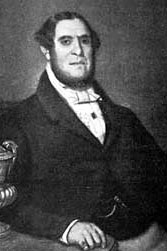
|
 |
|
Ben Caunt (1815-1861) |
James Greenacre (1785-1837) |
Dickens was clearly referring to the portrait's resemblance to Ben Caunt
and James Greenacre for comic effect. |

|
|
[ABOVE] A sketch of Charles Dickens done
from memory by the artist and portrait painter George Richmond, RA
(1809-1896). Richmond has written in pencil, below the sketch: "Charles
Dickens from recollection after dining with him and Charles Young The Actor
at Miss Burdett Coutts", lower centre. This picture possibly dates from
around 1852, the year Dickens commissioned Richmond to produce a portrait of
his eldest son Charley Culliford Dickens. |
|
|

|
"The Artist who operated
[John J. E. Mayall ?], is quite a genius in
that way, and has acquired a large stock of very singular knowledge of all
the little eccentricities of the light and the instrument ... Some of the
peculiarities inseparable from the process - as a slight rigidity and
desperate grimness- are in it [his portrait],
but greatly modified. I sat five times".
Letter to Angela Burdett-Coutts (1852) |

[ABOVE] An advertisement for
Mayall's Daguerreotype Portrait Gallery which appeared in an
advertising supplement in Charles Dickens' novel "Bleak House"
in 1853. |
| |
[ABOVE] An advertisement for John J. E. Mayall's Daguerreotype Portrait
Gallery at 224 Regent Street, London which appeared in The
Times newspaper on 4th August 1852. John Mayall invited the
public to inspect his "extensive Collection of Portraits of Eminent
Men". It is likely that Mayall would have included Charles Dickens in this
category. In 1853, Charles Dickens, who edited a weekly journal
called "Household Words", commissioned William Henry Wills
and Henry Morley to write an article entitled "Photography",
which involved a visit to Mayall's daguerreotype studio. The finished
article appeared in Dickens' "Household Words" on 19th March
1853. |
[ABOVE] Charles Dickens writing about his visit to
Mayall's Daguerreotype Portrait Gallery in 1852.
Regina B. Oost in her article "More Like Than Life: Painting, Photography, and
Dickens's Bleak House" notes that Dickens sat for his portrait at John
Mayall's daguerreotype studio in December 1852. A lengthy advertisement and
prospectus for Mayall's Daguerreotype Portrait Galleries appeared in
an 1853 edition of Dicken's novel "Bleak House". [See
illustration, right]. In 1853, two of Dickens journalists, William
H. Wills and Henry Morley,
visited John Mayall's daguerreotype studio in London before writing an
article entitled "Photography" (Published in Dickens'
journal "Household Words" on 19th March 1853. |
| 1854 |
 |

|
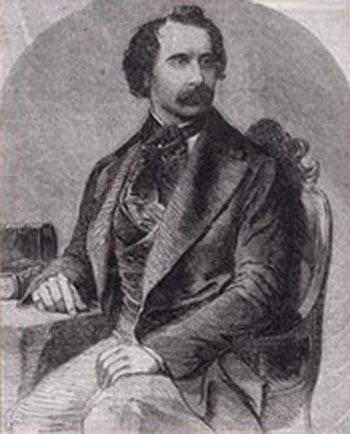
|
| |
[ABOVE] A daguerreotype portrait of Charles Dickens
(aged 42) by John Jabez Edwin Mayall
(1813-1901), a British portrait photographer who is known to have taken
several pictures of Charles Dickens in the late 1840s and early
1850s. The above daguerreotype portrait of Charles
Dickens in profile only recently came to public notice when it came up for
auction at Christie's on 11th May 2001. This particular daguerreotype
portrait can be identified as the work of John Mayall because the morocco
leather case is stamped with a gilt trademark which reads
Mayall 224 Regent St. & 433 West Strand London. Mayall's
previously unknown daguerreotype portrait of Charles Dickens was sold to a
private collector for £39, 950 (pounds sterling). |
[ABOVE] A photograph of Charles Dickens believed to
have been copied from a from a daguerreotype portrait by John J. E. Mayall.
It
appears that Dickens grew his moustache in 1853 or 1854. According to
William Powell Frith's Autobiography, John Forster had first
asked him to paint a portrait of Dickens in 1854, but work on the picture
was delayed because about that time Dickens had begun to grow a moustache,
which Forster regarded as a "hideous disfigurement". This image was later used on a stereoscopic slide. A stereoscopic
portrait of Charles Dickens was apparently exhibited by John Mayall
at the Photographic Society's exhibition in London in January 1855 (see
below) and an albumen print version was also later produced. |
[ABOVE] An engraving of Charles Dickens "taken from a
daguerreotype by J. J. E. Mayall" (c1853) which was published as an
illustration
in the "Illustrated Times" on 1st December 1855. The
original image was clearly taken at the same sitting as the daguerreotype
photograph illustrated on the left. In the engraved version Dickens sits in
the same ornately carved chair and wears identical clothing. There are
slight differences in the tilt of the head and the position of the
novelist's hands. These slight differences could be down to "artistic
license" on behalf of the illustrator, but the discrepancies might also
indicate that Dickens adopted more than one pose and several daguerreotypes
were made that day in Mayall's London studio. Mayall's daguerreotype of
Dickens in profile might have been taken at the same sitting. |
| 1855 |
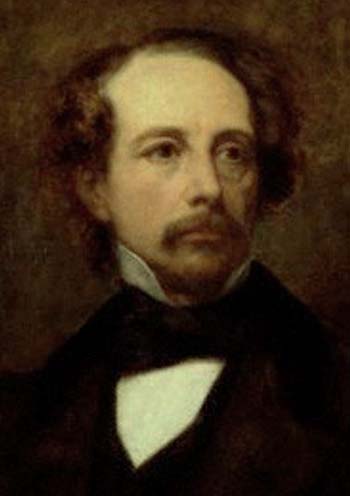
|
|
| 1855 |
[ABOVE] Charles Dickens (aged 43). A portrait painted by the artist
Ary Scheffer (1795-1858) which is signed and dated 1855. Ary
Scheffer, the son of a German artist, was born in Dordrecht in
the Netherlands in 1795, but as a teenager he was taken to Paris by his
widowed mother to study art and painting. Scheffer trained as a painter in
the studio of Pierre-Narcisse Guerin and in the 1830s painted many works
based on scenes from literature. When Dickens stayed in Paris in 1855, he
was introduced to Ary Scheffer, who "expressed a wish to paint him".
Dickens' portrait was painted by both Ary Scheffer and his artist brother
Henri Scheffer
during November 1855. Dickens was bored by the long sittings and in a letter
to his friend John Forster in December 1855 wrote "the crowning feature
is, that I do not discern the slightest resemblance, either in his (Ary
Scheffer's) portrait or his brother's!" In Scheffer's portrait there
is a hint that Dickens had already started to grow the beard that is so familiar in
the photographs taken by Watkins and others after 1858. |
|
Portraits of the Artists who created likenesses of Charles Dickens
between 1839 and 1855 |
|
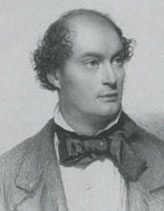
|
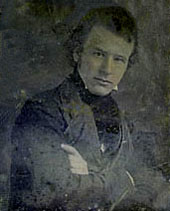
|
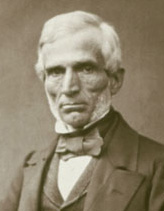
|
 |
| Daniel Maclise
(1806-1870). Maclise was born in the Irish city of Cork. Maclise
arrived in London in 1827 and from 1829 exhibited his work at
the Royal Academy. Primarily an historical painter, Maclise made
a number of portraits in the 1830s. |
John Jabez Edwin Mayall
(1813-1901). Mayall was
born in Lancashire in 1813. After working as a
daguerreotype artist in the United States, John Mayall opened a photographic
portrait studio in London in 1847. |
Antoine Claudet
(1797-1867). Born in Lyons, France, Claudet established a glass
company in London in 1829. In June 1841, Claudet opened a
photographic portrait studio in London's West Strand. |
Ary Scheffer (1795-1858). Born
in the Netherlands, the son of a German artist, Scheffer spent
most of his artistic career in Paris. He produced a number of
portraits of famous people during the 1840s and 1850s. |
|
|
| 1856 |

|
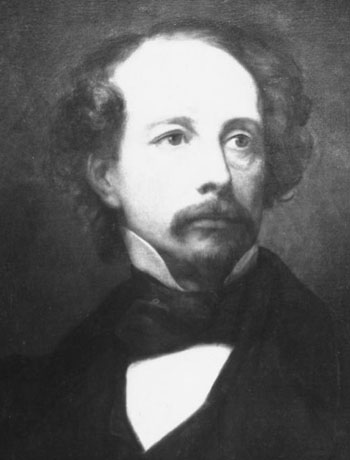
|

|
| |
[ABOVE] A portrait of Charles Dickens (1856) taken
from an engraving showing Charles
Dickens speaking at The Dulwich College Charity Meeting at the Adelphi
Theatre in March 1856. The engraving appeared as an illustration in
the Illustrated London News on 22nd March, 1856.
The head of the figure of Dickens is clearly taken from a photograph very
similar to the stereoscopic picture of Dickens taken by Mayall before 1855.
Charles Dickens was clean-shaven in 1850, but he grew a moustache before
1854. In this picture, Dickens, in addition to the moustache, now sports an
"imperial" (a tuft of hair which runs from below his bottom lip to his chin)
which heralds the arrival of his famous chin beard.
On 4th October 1856, Charles Dickens turned down John Mayall's
invitation to sit for a photographic portrait because of his "disinclination
to multiply my 'counterfeit presentments'" |
[ABOVE] Charles Dickens (aged around 44). A black and
white reproduction of Ary Scheffer's portrait of Charles Dickens
which shows the author with a small, pointed beard. A later copy of
Scheffer's portrait (right) circulated in 1856 shows more clearly the beard
that Dickens started to grow during his stay in Paris.
 |
[ABOVE] Charles Dickens (aged around 44). A later
copy of Ary Scheffer's portrait of Charles Dickens originally
painted in 1855.
DICKENS DECLINES TO BE PHOTOGRAPHED
On 4th October 1856, in a letter to John E. Mayall, Charles
Dickens turned down the photographer's invitation to sit for a photographic
portrait: "I fear it will not be in my power to sit
- I have so much to do and such a disinclination to multiply my 'counterfeit
presentments' - but I am not the less sensible of your valuable offer."
|
[LEFT] Charles Dickens,
sporting a goatee beard, pictured in 1857
stretched out on the grass in front of an assembled group of friends,
colleagues and relatives. |
|
|
|
| No authenticated
photographic studio portraits*of Charles Dickens are available from
1856-1857. This is
probably a result of Dickens' decision not to give sittings to
professional photographers during this period. (Dickens objected to
his portrait being sold commercially). In December 1856, Dickens
wrote: "Apart from my
having an invincible objection to the multiplication of my countenance
in the shop-windows, I have not, between my avocations and my needful
recreation, the time to comply with these proposals
(for portrait sittings)".
In December 1856, Charles Dickens confided to William Charles Kent that he had
tentatively agreed to sit for three professional photographers, yet
went on to write: "But I
assure you, I consider myself almost as unlikely to go through these
three conditional achievements as I am to go to China".
* There is at least one semi-informal group
photograph from this period that features Charles Dickens. The
National Portrait Gallery has a photogravure print of a group
photograph taken in 1857 in the garden of Albert Smith at Waltham
Green. Amongst the two dozen figures in this photo are Charles Dickens and
two of his grown-up children, Charley Culliford Dickens and Mary
Dickens. Charles Dickens sporting a goatee beard is shown
stretched out on the grass in front of the assembled group. |
|
Below, is a letter written in December 1856 by
Charles Dickens to the critic and poet William Charles Kent
(1823-1902 ) declining the invitation to be photographed by a professional
photographer. It appears that William Kent had suggested that the
famous novelist should have his likeness taken by the photographer Mr
Watkins (probably George Herbert Watkins). Kent's request might
have been connected with Herbert Fry's attempt to collect together a "National
Gallery of Photographic Portraits" in 1856. (See entry on the right)
"I cannot leave your letter unanswered, because I
am really anxious that you should understand why I cannot comply with your
request.
Scarcely a week passes without my receiving
requests from various quarters to sit for likenesses, to be taken by all the
processes ever invented. Apart from my having an invincible objection to
the multiplication of my countenance in the shop-windows, I have not,
between my avocations and my needful recreation, the time to comply with
these proposals. At this moment there are three cases out of a vast number,
in which I have said: "If I sit at all, it shall be to you first, to
you second, and to you third". But I assure you, I consider myself almost as
unlikely to go through these three conditional achievements as I am to go to
China. Judge when I am likely to get to Mr. Watkins!"
Letter to William Charles Kent (Christmas Eve, 1856) Herbert
Watkins produced hundreds of photographic portraits of famous men, but
it appears that less than two dozen were published with printed biographies under the title
of Herbert Fry's National Gallery of Photographic Portraits.
In his advertisements, Herbert Watkins declared that his photographic
portraits were "as
remarkable for their agreeable fidelity to nature as for their brilliancy of
production and their economy of cost". |
In 1856, Herbert Fry (1830-1885), a compiler of guide
books and handbooks, attempted to form a "National Gallery of
Photographic Portraits". During 1856, letters were sent out by
Herbert Fry to many of the leading personalities of the day (artists,
writers, scientists, politicians, etc.) asking them to sit for a
photographic portrait. Herbert Fry had arranged for a professional
photographer George Herbert Watkins (born 1828) to take the
portraits. A number of the celebrities whom Herbert Fry approached
declined his invitation to take part in his photographic project. (Charles
Dickens appears to be one of many who refused to be photographed - see
Dickens' letter to William Charles Kent written on 24th December
1856, shown left).
A number of photographic portraits were taken of some of the leading
personalities of the day by (George)
Herbert Watkins of 179 Regent Street, London. From March or
April, 1857, Herbert Fry issued 16 prints under the title of "Herbert
Fry's National Gallery of Photographic Portraits". (Number 1 was a
photographic portrait of Lord Palmerston which, together with a biography
written by Herbert Fry, was priced at 4 shillings). Other photographic
portraits by Herbert Watkins which were published by Herbert Fry between
1857 and 1858 included the writer and
poet Walter Savage Landor, the veteran soldier Sir Colin Campbell and the
Reverend Connop Thirlwall, Bishop of St David's.
A selection of the prints in Herbert Fry's series National Gallery
of Photographic Portraits were reviewed The Athenaeum journal
on 29th May 1858.
When Herbert Fry's project of creating a "National
Gallery of Photographic Portraits" collapsed, the photographer Herbert
Watkins continued to issue his portraits of famous men as albumen prints and
later as "celebrity cartes-de-visite".
|
|
1858 |

|

|
Charles Dickens' Beard. It appears that Charles
Dickens had grown his "door-knocker" beard before 1857. John Forster
first commissioned William Powell Frith to paint a portrait of
Dickens in 1854, but work on the painting did not start because Dickens had
recently grown a moustache. According to Frith, John Forster said : "This
is a whim, the fancy will pass. We will wait till this hideous disfigurement
is removed". But as James Ley remarked, "the fancy did not pass" and
"the moustache was followed by a beard". When friends commented on his new
beard, Dickens responded that "the beard saved him
the trouble of shaving, and much as he admired his own appearance before he
allowed his beard to grow, he admired it much more now, and never neglected,
when an opportunity offered, to gaze his fill at himself. If his friends
didn't like his looks, he was not at all anxious for them to waste their
time in studying them ... Besides, he had been told by some of his friends
that they highly approved of the change, because they now saw less of him". |
| |
[ABOVE] A portrait of Charles Dickens (1858) engraved
by Daniel J. Pound from an earlier photograph by John Jabez Edwin
Mayall. In an 1859 publication called "Town Talk" an engraved portrait
of Charles Dickens is described as being taken "from a recent
daguerreotype by Mayall". The picture of Dickens above was described as
"a portrait engraved on steel by D. J. Pound, from a photograph by Mayall,
London" when it was published as a Supplement to the Illustrated
News of the World on 9th October, 1858. During the engraving
process, a beard has been added to Mayall's original image of Dickens. In
Mayall's original daguerreotype portrait of Dickens taken around 1853, the
author had a moustache but no chin beard.
|
[ABOVE] An advertisement for an engraved print of "Charles
Dickens, Esq., the Popular Author, from a photograph by MAYALL, engraved on
Steel by D. J. Pound", which appeared in The Athenaeum
journal on 9th October 1858. Presented with an issue of the
Illustrated News of the World and featured as No. 36 in John
Mayall's "National Portrait Gallery of Eminent Personages".
According to Mayall's advertisement, the Charles Dickens portrait alone was
worth 2s 6d, but could be bought for 6d, together with a "Memoir" of
Dickens. On 4th October 1856, Dickens had turned down John Mayall's
invitation to sit for a photographic portrait, but in the same letter
suggested that the photographer might like to take some pictures of his
dramatic group performing scenes from a play.
"I shall hope, about Christmas time, to shew you
some dramatic groups here, which you may perhaps feel an interest in
presenting. In which case, I am sure that all concerned (including myself)
will be delighted in giving you the opportunity." Letter to
J. E. Mayall (4th October, 1856) |

[ABOVE] "Love, Pride, Revenge", a cartoon by
John Leech published in October 1857, which shows a photographer taking a
picture of a group of actors acting out a scene from a play. In October
1856, Charles Dickens invited the London photographer John Mayall to take
photographs of his dramatic groups in action. |
| 1858 |
 |
 |
 |
| |
[ABOVE] A portrait of Charles Dickens (aged 46) photographed by George Herbert Watkins,
probably between April and June 1858.
Dickens wrote to (George) Herbert Watkins on 17th July 1858 to
say that he was glad to hear that the portraits taken at Watkins' studio had
turned out well and requested "five and twenty impressions for private
friends". In a letter to (George) Herbert Watkins sent in
November 1859, Charles Dickens wrote: "I send you a thousand thanks for
the remarkable, interesting and admirable collection of Photographs you have
sent to me". This is probably a reference to the photographic
portraits of famous personalities which Watkins had taken between 1856 and
1858 for Herbert Fry's "National Gallery of Photographic Portraits"
project. |
[ABOVE] Charles Dickens photographed by G.
Herbert Watkins in 1858. George Herbert Watkins was taking
photographic portraits at 179 Regent Street, London in 1856 and by
November 1857 he had opened a
photographic portrait studio at 215 Regent Street, London. (George) Herbert Watkins
(born 1828) was one of three photographer brothers. Herbert's brother John Watkins
(born 1823), a former studio manager with Richard Beard, had been running his own portrait studio at 34
Parliament Street, London since 1851. Another brother Octavius Charles
Watkins was also a professional photographer. There is evidence that Charles Dickens had been invited to
be photographed by a "Mr Watkins" in December 1856. In December
1856, Dickens wrote to William Charles Kent declining his request to arrange
a sitting with Mr Watkins. |
[ABOVE] Charles Dickens as he appeared in an
engraving after a drawing by the Belgian artist Charles Baugniet
(1814-1886). A Court Painter to the Belgian Royal Family, Charles
Baugniet travelled to London in 1843 to make a portrait of Queen
Victoria's husband, Albert, the Prince Consort. Baugniet appears to have
settled in London. In February 1846, Charles Baugniet is recorded as
a "French lithographer" residing at 21 Beaumont Street, London . In
1858, the year that Charles Baugniet created the portrait of Charles
Dickens, Charles Baugniet also produced lithographic prints of other
famous British personalities such as the artist William Powell Frith,
General Sir Colin Campbell, Major-General Sir James Outram and Sir Herbert
Benjamin Edwardes. The prints of Charles Dickens and the others mentioned
sold for 5 shillings each. |
| 1858 |
 |

|

|
| |
[ABOVE] A portrait of Charles Dickens (aged 46) photographed by
(George) Herbert Watkins on 29th April 1858. This was one of a
number of photographs Watkins took of Charles Dickens in the pose of a
lecturer. During this period Charles Dickens was giving public readings of
his works. |
[ABOVE] A portrait of Charles Dickens wearing a
tartan waistcoat, photographed by G. Herbert Watkins in
1858. This portrait was one of several taken of
Charles Dickens at Herbert Watkins' photographic studio at 215 Regent Street, London
in 1858. |
[ABOVE] Charles Dickens (aged 46) as he appeared in a
lithographic print produced in 1858 by the Belgian artist Charles
Baugniet (1814-1886). A lithographic portrait of Charles Dickens
by C. Baugniet appears under the heading of "List of New
Engravings Published in 1858" published in The Literary and
Educational Year Book for 1859. |
| 1859 |

|

|

[ABOVE] A portrait of Charles Dickens
wearing a velvet jacket photographed by George Herbert Watkins
in 1858. This particular portrait is probably one of several taken of
Charles Dickens at Herbert Watkins' photographic studio at 215 Regent Street, London.
The sitting had been arranged by the artist William Powell Frith, who
had been commissioned to paint Dickens' portrait. William Powell Frith
was not satisfied with the resulting images and decided not to use
Watkins' photographs when he painted Dickens' portrait. |
| |
[ABOVE] Fig.1. Charles Dickens (aged 47). A
detail from the oil painting "Portrait of Charles Dickens" by
William Powell Frith (1819-1909). The portrait was commissioned by
Dickens' friend John Forster and completed in 1859. Writing in his
autobiography many years later, William Powell Frith wrote: "As I had
heard that portrait painters had often derived advantage from photography, I
asked Dickens to give me a meeting at Mr Watkins's, who was thought one of
the best photographers of that day. In due course the photograph was taken;
but not very successfully, nor did I derive the slightest assistance from it
in the prosecution of the portrait". The photographer in question was
George Herbert Watkins (born 1828, Crowle, Worcs.) who took several portraits of
Charles
Dickens during 1858. (see a selection above). |
[ABOVE] A detail from one of several versions of the "Portrait
of Charles Dickens" painted by William Powell Frith in 1859.
William Powell Frith, who was on friendly terms with Dickens and had painted
characters from Dickens' novels for the author (e.g. Dolly Varden from
Barnaby Rudge and Kate Nickleby from Nicholas Nickleby),
was commissioned by John Forster to paint a portrait of Dickens at home in
his study. Dickens is posed in front of his desk, on which is the opening
chapter of his novel "A Tale of Two Cities", which was released in
instalments in April 1859. John Forster, who had commissioned the
portrait was delighted with the painting, telling the artist that he "never
doubted your perfect success from the first moment I saw the canvas... the
picture is, indeed, all I wished - more than I dared to hope - because I
know what a ticklish thing a likeness is". Charles
Dickens had reservations about his own facial expression in the portrait.
Dickens thought it was the face of a man who had just heard that a
misfortune had befallen an unfriendly neighbour. |
[ABOVE] A bearded Charles Dickens photographed
by George Herbert Watkins in 1858. William Powell Frith began
work on his portrait of Charles Dickens in 1858. John Forster had
suggested that Frith should paint a portrait of his novelist friend in 1854,
but he delayed his commission because Charles Dickens had grown a moustache,
which Forster considered a "hideous disfigurement". It soon
became clear that Dickens was not going to shave off the offending moustache
and, by the end of 1855, Dickens had even started to grow a beard. By 1858,
Forster had accepted that Dickens was not going to return to his
clean-shaven appearance and gave Frith the go ahead. Frith arranged for
Dickens to be photographed at Herbert Watkins' London studio, but the artist
maintained that he did not "derive the slightest assistance from it
(the photograph) in the prosecution of the portrait". |
| 1860 |

|

|

|
| |
[ABOVE] Charles Dickens (aged around 48). An
illustration which appeared in the American publication
Harper's Weekly on 24th November 1860 with the caption
"Charles Dickens Esq. (From a late photograph)". The original image
has been reversed during the printing process. The engraver of the woodblock
print has also added a square shaped beard which was not present in Mayall's
photograph. |
[ABOVE] A portrait of Charles Dickens (1858) engraved
by Daniel J. Pound, from an earlier photograph by John Jabez Edwin
Mayall, which was presented with a Supplement to the Illustrated
News of the World on 9th October, 1858. The engraver has added a
full beard to Dickens' chin, which was only stubble in the John Mayall
photographs taken around 1854. |
ABOVE] A photographic portrait of Charles Dickens by
John Jabez Edwin Mayall (circa 1854), which probably provided the
basis of the engraved portraits of Charles Dickens which circulated between
1855 and 1861. The engraved illustrations which were published after 1857
had been doctored to show Dickens with a square shaped beard. |
| 1861 |

[ABOVE] Charles Dickens (aged 49). A
detail from a photograph by the London portrait photographer George Herbert Watkins.
It is the photographic portraits taken by (George) Herbert Watkins
between 1858 and 1861 which have helped define the enduring image of
Dickens as a care-worn, slightly melancholy figure. |
|
"If anybody thinks
to obtain an accurate idea of Dickens from the photographs that flood the
country, he is mistaken. He will see Dickens's clothes, Dickens's features,
as they appear when Nicholas Nickleby is in the act of knocking down Mr.
Wackford Squeers; but he will not see what makes Dickens's face attractive,
the geniality and expression that his heart and brain put into it. In his
photographs Dickens looks as if, previous to posing, he had been put under
an exhausted receiver and had had his soul pumped out of him. This process
is no beautifier. Therefore let those who have not been able to judge for
themselves believe that Dickens's face is capable of wonderfully varied
expression. Hence it is the best sort of face. His eye is at times so keen
as to cause whoever is within its range to feel morally certain that it has
penetrated his boots; at others it brims over with kindliness ... here is a
twinkle in it that, like a promissory note, pledges itself to any amount of
fun--within sixty minutes. After seeing this twinkle I was satisfied with
Dickens's appearance, and became resigned to the fact of his not resembling
the Apollo Belvedere".
Kate Field (1838-1896), an American actress and journalist writing in
1871. |
|
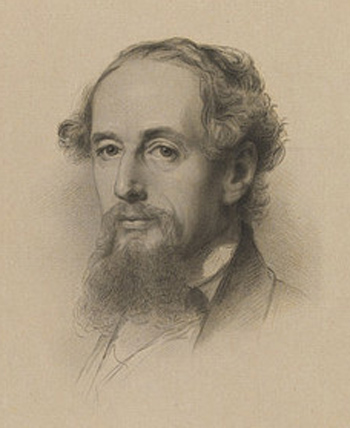
[ABOVE] Charles Dickens after a portrait by the
German artist Wilhelm A. R. Lehmann (1861). |
| |
[ABOVE] A portrait of Charles Dickens (aged 49) photographed by George Herbert Watkins
around 1861. George Herbert Watkins (who was generally known as
Herbert Watkins) was born in Crowle, Worcestershire in 1828. In 1856,
Herbert Watkins had been commissioned by Herbert Fry to
photograph a large number of famous men for Fry's series of photographic
prints entitled the "National Gallery of Photographic Portraits".
In 1856, Charles Dickens declined an invitation to sit for Herbert
Watkins for Herbert Fry's "National Gallery" project, but he did have a
number of photographic portraits taken at Herbert Watkins' studio between
April and July 1858. Charles Dickens was photographed many times by Herbert
Watkins between 1858 and 1861. |

[ABOVE] A cartoon published
in 18th January 1862 |
[ABOVE] Charles Dickens (aged 49). A stipple engraving produced in the early 1860s by
Edward William Stodart, (1841-1914) after a portrait of Charles
Dickens by Wilhelm Augustus Rudolf Lehmann (1819-1905). Lehmann,
a German-born artist visited England regularly, eventually settling in
London in 1866. The original pencil drawing (now in the British Museum) is
inscribed "R. Lehmann del./London. May 20th./1861" and is
autographed by Dickens. Lehmann's picture of Dickens, showing him with a
slight smile and large bright eyes, seems closer to the genial and lively
character described by Kate Field than most of the photographs of the
time. As the American actress observed, in his photographic portraits
"Dickens looks as if, previous to
posing, he had been put under an exhausted receiver and had had his soul
pumped out of him". |






















